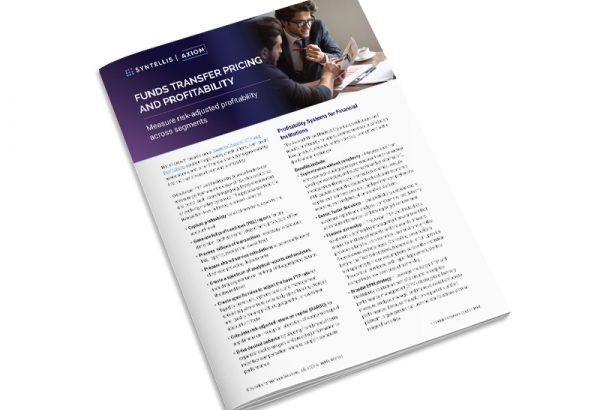Amid the tumult of the past couple of years, one piece of enduring good news should be emphasized — our country survived what could have been a significant financial crisis, thanks in part to the lessons learned in 2008.
When I talked to bankers and my colleagues in the consulting industry in March 2020, there was considerable concern about what was about to happen. During the 2008 financial crisis, we saw quite a bit of trouble among the nation’s financial institutions. One problem many institutions faced was a lack of focus on the controls and the processes related to measuring risks and their respective returns. .
The industry learned its lesson in 2008 by investing not only in technology but also in policies and procedures to more accurately measure those risks and returns. That focus on the never-ending balance of risk and return goes to the very heart of funds transfer pricing (FTP), separating the return you are earning because of the risks you're assuming and the services you provide.
Significant changes are anticipated in 2022, including higher interest rates and a dramatically different yield curve, which will impact pricing strategies and exposure to changes in interest rates. Financial institutions must ensure their profits are commensurate with the interest rate, market, liquidity, credit, and operational risks they are assuming.
Control What You Can Measure
We often think about FTP as a tool to measure the profitability of products, organizational units, customer accounts, and loan officers. However, it's also important as a risk metric to measure the returns based upon interest rate exposure and to centralize rate and liquidity risk where it can be more efficiently managed.
The best practice approach to FTP uses matched-maturity funds transfer pricing, which breaks apart net interest margin or net interest income into component parts and enables institutions to manage those component parts. In other words, it breaks your overall margin into Credit, Funding, and Rate Risk Funding parts. Are you fairly compensated for the credit risk you are assuming? How valuable is the retail franchise in its ability to attract money cheaper than marketplace alternatives? These are some of the insights that you can gain.
Existing tools such as ALM models or data warehouses typically contain the data you need to implement an FTP approach to managing your company.
Examples of FTP in Action
Funds transfer pricing can help banks and credit unions make critical business decisions that mean the difference between success and failure.
Here are six real-world examples of FTP in action:
- Evolution to line-of-business profitability. Historically, larger banks have led the way in moving from a legal entity point of view toward a line-of-business view, but we’re seeing this trend among more mid-size and smaller institutions. The statutory barriers of operating in different geographies and lines of business have all but been removed. Without these barriers, banks can view their organization more from a functional perspective.
- Make better product decisions. At one bank where I worked,we looked at our cost of funding for indirect lending and realized that it was actually not profitable if you considered market rates, the spread shared with dealers, and a higher overall cost to serve this market.
- Branch profitability discoveries. In another instance, we realized a certain branch viewed as very profitable was only that way because of a favorable lease on the building. The banking activities occurring at that branch — the loans and deposits they attracted — really weren’t contributing much to the bank's overall profitability.
- Rate risk management. We assessed rate risk management for the complete balance sheet and realized that the overwhelming percentage of our earnings were based on one enormous rate bet. We spread out our risk through hedging and other activities to reduce possible spikes in risk.
- Relationship profitability. The rules of thumb that bankers follow — such as older people and wealthier people are your most profitable customers — may not hold true. Institutions need to look at total relationships on a retail level and a commercial level. You may be surprised at what you find. In this case, it’s not only the funding costs but the costs to serve these customers as well.
- Regulatory requirements. Following the 2008 financial crisis, the FDIC adopted more stringent rules to incorporate contingent and operational liquidity risk assessments in FTP processes.
Start with the Right Tools
To maximize profits and shareholder value, institutions must have sufficient visibility into the customers, segments, branches, and products that drive the greatest value for your institution. Enabling technology is critical for institutions to employ transparent measurement processes to calculate FTP and allocate non-interest income and expense, loan loss, and capital.
Look for technology that brings data together on a common platform to allow insightful decision-making, such as Axiom. Using FTP may represent a new approach for many institutions, so be prepared to provide change management to support new ways of thinking throughout the organization.
Read more on managing profitability with FTP

Profitability Check-ins: Maintaining the Momentum

Tips for Financial Agility and Sustainable Growth in 2022


